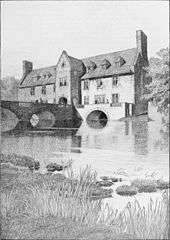Charles Edward Mallows

Charles Edward Mallows FRIBA (5 May 1864 – 2 June 1915), often known as C. E. Mallows, was an English architect and landscape architect. He is considered to be part of the Arts and Craft movement in British art.
Biography
Mallows was born in Chelsea, London and spent his childhood at Flatford Mill, East Bergholt, Suffolk where his uncle ran the mill. He studied in Bedford and London.
In 1895 he opened an office in Bedford with George Grocock and worked in the Arts and Crafts tradition designing cottages, schools, shops and restoring churches including the Trinity chapel of St Paul's Church, Bedford. He was made a fellow of the Royal Institute of British Architects in 1900 and by the following year was the diocesan surveyor for Ely. Mallows rented rooms adjoining those of the landscape architect Thomas Hayton Mawson, and occasionally worked with him.
He died in 1915 at Biddenham, Bedfordshire leaving an estate of nearly £3,000.[1]
Works
Mallows's major commission was Tirley Garth in Cheshire, where, from 1907, he designed the house and the major part of the gardens.
He remodelled the house and gardens of Cannons in Stanmore, London between 1905-1908. The gardens were considered by some to be the greatest to be designed in the Edwardian era. [2]
He also designed Joyce Grove in Oxfordshire for Robert Fleming between 1903 and 1908.
References
- ↑ Waymark, Janet (2004), "Mallows, Charles Edward (1864–1915)", Oxford Dictionary of National Biography, Oxford University Press, retrieved 27 October 2008 ((subscription or UK public library membership required))
- ↑ North London Collegiate School (2015). "The History of Canons".